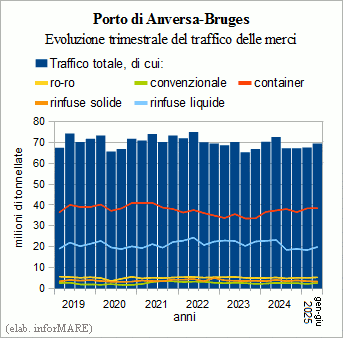
In the second quarter of this year, the port system of
Antwerp-Bruges recorded a year-on-year decline in the traffic of the
goods similar to that of the previous quarterly period, having
69.6 million tons of cargo handled, with a decrease
-4% over the April-June period of 2024. The decrease is
was mainly generated by the contraction in the volumes of
liquid and solid bulk cargo, which stood at
19.9 million tonnes (-14%) and 3.3 million tonnes (-19%)
as well as the more contained reduction in traffic of
which fell by -3% to 2.6 million
Tons. On the other hand, freight traffic is growing
containerized which was 38.6 million tons
(+3%) with a container handling of 3.5 million
TEU (+3%) and rolling stock traffic which totalled 5.3 million
of tons (+1%). The handling of new cars has
recorded an increase of +9% rising to 855 thousand vehicles.
 In the first six months of 2025, the Belgian port of call
handled a total of 137.2 million tons of goods,
with a decrease of -4.3% on the first half of last year
year. As well as in the second trimester alone, in the first
volumes of containerized goods increased, with a
total of 77.0 million tons (+3.6%) and a handling of
box equal to 6.9 million TEUs (+3.7%), and those of ro-ro goods with
10.4 million tons (+1.4%). Liquid bulk cargo with
38.3 million tons (-17.1%), dry bulk with 6.8 million tons
million tonnes (-11.0%) and conventional goods with 4.8 million tonnes
million tons (-4.3%). In the new car sector, the
traffic was over 1.6 million units
(-4,1%).
In the first six months of 2025, the Belgian port of call
handled a total of 137.2 million tons of goods,
with a decrease of -4.3% on the first half of last year
year. As well as in the second trimester alone, in the first
volumes of containerized goods increased, with a
total of 77.0 million tons (+3.6%) and a handling of
box equal to 6.9 million TEUs (+3.7%), and those of ro-ro goods with
10.4 million tons (+1.4%). Liquid bulk cargo with
38.3 million tons (-17.1%), dry bulk with 6.8 million tons
million tonnes (-11.0%) and conventional goods with 4.8 million tonnes
million tons (-4.3%). In the new car sector, the
traffic was over 1.6 million units
(-4,1%).
With regard to six-monthly container traffic, the
port of call highlighted that the sector has held up well
even in the presence of persistent traffic congestion in
this business segment that is putting a strain on the
capacity of the terminals, a challenge - the Authority recalled - which is
common to all ports in north-western Europe. The authority has
explained that several factors contribute to the current congestion,
including the irregularity of container ship arrivals in
due to dysfunctions dating back to the Covid crisis which - has
specified the body - have been further aggravated by the
deviation of routes around the Cape of Good Hope to avoid
the Red Sea. In addition, the recent reorganization of alliances
of shipping companies in the container sector has led to
simultaneous port calls of ships and high volumes of
cargo handled in ports. In addition to this, the scarce
reliability of ship arrival and departure times
complicates the planning of the terminals where containers stay the most
for a long time and ships arrive with more and more cargoes
Consistent. Consequently - the authority announced - the timing
average stay times have increased to 7-8 days compared to traditional
five days. In addition to this, national trade union actions
which have further increased operational pressure. The Authority
has specified that if congestion on the water side and the
related waiting times for ships currently remain
the impact on land-side terminals,
instead, it is critical.